The Camellia sassanqua is one of the joys of Autumn and Winter with it's beautifully fragrant flowers through an extended period. It is a smaller leaved, and faster growing cousin the the Camellia japonica. Sassanquas are best grown in the full sun, and make good specimen plants or are great as a screen or hedge. They come in many varieties, dwarf plants of tall growing plants, and are available in many colours. You can also choose from single flowered varieties, or double flowered. Flowers of the older varieties have a great smell or perfume. "Plantation Pink" is a single-flowered variety which is taller growing, the flowers have an intense perfume which makes it my favourite. Native to China and Japan, these plants are best suited to temperate or Cooler climates.
The photos of these Sassanquas were taken locally in Sydney.
Camellia sasanqua become extremely well in our Sydney atmosphere, offering evergreen structure and foundation greenery, and additionally wonderful blossoms. Once settled, they are extreme and pardoning. They are especially valuable for making formal auxiliary components in the garden, which can give an unmistakable difference to the blowzy, rich type of some warm-atmosphere plants. They are extremely flexible and can be utilized for high or low supports or screens; espaliered on dividers or over curves; prepared as models; developed in holders; or utilized as thick component bushes at plant doorways or in blended greenery. They can be pruned to a solitary trunk and their lower branches expelled to give the impact of a little tree. Statures run from 1-4m, even to 5-6 m or more with age in a few occasions. There are significantly groundcover variants.
These plants are extremely versatile, and will develop in full sun or part shade. In full shade, their development will turn out to be somewhat straggly and they won't bloom extremely well. They appreciate all around depleted, humus-rich, marginally acidic soil (pH 5.5-6) which is wet in summer; a waterlogged soil is exceptionally inadmissible. They should be watered about two times every week in droughts in their initial years; after the fact, they will wind up sufficiently versatile to make due with minimal additional watering. In any case, blooming is more productive in years with a lot of rain. They value a light mulch, ideally of cow excrement, to ensure their shallow root-framework in spring and summer, and to help hold dampness in the dirt and to give a stream of supplements through the developing season.
Bolstering with a dissolvable compost at regular intervals from September to May has an extremely advantageous impact on their development; or a moderate discharge granular sustenance can be utilized as a part of spring. Numerous planters trust that nourishing with an authority camelia sustenance has an extremely advantageous impact on their development. A light pruning in the wake of blossoming is normally prescribed for denser development however isn't obligatory, aside from formal fences which ought to be pruned in spring.
The common camellia (C. japonica) begins as a shrub but usually ends up as a tree, 15 to 25 feet high and wide. So it takes up a lot of space--not exactly the perfect choice for planting under eaves and windows or between the sidewalk and curb. A mature sasanqua is smaller. Upright selections can grow 10 to 12 feet high and wide.
Mounding types, popularly called dwarf sasanquas, grow only 2 to 5 feet tall and wide. Therefore, when you plant one of these, you won't have to worry that your house with a camellia out front will morph into a camellia with a house in back.
Depending on the selection and where you live, sasanquas can bloom any time from late summer through autumn and into winter. Flowers may be single, semidouble, or double, usually with a central burst of bright yellow stamens. Some exude a pleasant tea scent--not surprising, as sasanqua is closely related to the tea plant.
Colors range from cherry red to rose to shell pink to fairest white. Individual flowers live but a short time, shattering into a storm of falling petals. Abundant new flowers soon replace them, though, and the carpet of petals at the foot of the shrubs only adds to the spectacle.
Camellia sasanqua, commonly known as sasanqua camellia, is a densely branched, pyramidal to oval-rounded, tree-like, evergreen shrub that typically grows to 6-10’ tall. It is native to Japan. It is ornamentally noted for its attractive dark green foliage and fall to early winter flowers. Lustrous, narrow-oval to obovate, dark green leaves (to 3” long) are cuneate and hairy on the midrib with rounded marginal teeth and pubescent petioles.
Stems (reddish when young) are covered with significant pubescence. White to pale pink, 6-8 petaled, mildly aromatic flowers (2-3” diameter), each having a central mass of bright yellow-anthered stamens, bloom late summer to early winter depending on local climate. Petals fall after several days but stamens remain, with additional flowers continuing to open in succession over a period of 4-6 weeks.
Flowers are followed by small rounded fruits. Species flowers are single, but cultivar flowers often come in single, semi-double or double-flowered forms, with flower colors ranging primarily from white to red. Fruit is a smooth and shiny capsule (to 3/4" long).
Genus name honors Georg Joseph Camel (1661-1706), a German Jesuit missionary to the Philippines who was noted for his work on Oriental plants.
Specific epithet comes from the Japanese name sasankua for a popular native species of Camellia.
Very beautiful flower. I for some reason thought it was flowers, and thanks to you I learned that Camellia is a flowering tea bushes. Basically, it occurs in the subtropics of Eurasia and North America, but can also be cultivated as a house or greenhouse plant around the world. Camellia is used for decorative purposes, and also has medicinal properties. Leaves of some species serve as raw materials for tea. Many growers are afraid to grow the plant because of a capricious nature, but it is enough to study several characteristics of care so that, avoiding problems, enjoy amazing flowers. The international classification of camellia includes more than 250 species. Japanese jam. The most common among gardeners is a plant in the form of a sprawling shrub or tree 1.5-6 m high
Camellia Japanese
Camellia Chinese
Camellia will have to be watered regularly, so that the soil is constantly slightly moist, but not waterlogged. Irrigation continues in winter at positive temperatures. very beautiful plant. Thanks for sharing.
Camellia sasanqua, with common name sasanqua camellia,[1] is a species of Camellia native to China and Japan. It is usually found growing up to an altitude of 900 metres.
It is an evergreen shrub growing to 5 m tall. The leaves are broad elliptic, 3–7 cm long and 1.2–3 cm broad, with a finely serrated margin. The flowers are 5–7 cm diameter, with 5–8 white to dark pink petals.
History and uses
At the beginning of the Edo period, cultivars of Camellia sasanqua began appearing; the first record of the cultivars of this plant was made by Ihei Ito (1695–1733).[2] In Japan, it is not considered to be a true Camellia as the Japanese call it Sazanka (サザンカ, 山茶花).[3]
Camellia sasanqua was not known in western societies until in 1820 Captain Richard Rawes of the East Indiaman Warren Hastings brought "Camellia sasanqua, var. β. stricata" to his relation, Thomas Carey Palmer, of Bromley in Kent.[4] Then in 1869, Dutch traders imported some specimens into Europe. It is now also introduced to Australia and the United States.[3]
It has a long history of cultivation in Japan for practical rather than decorative reasons. The leaves are used to make tea while the seeds or nuts are used to make tea seed oil,[5] which is used for lighting, lubrication, cooking and cosmetic purposes. Tea oil has a higher calorific content than any other edible oil available naturally in Japan.[3]
Camellia sasanqua is valued in gardens for its handsome glossy green foliage, and fragrant single flowers that can range in color from white to deep pink and are produced extremely early in the season. Various cultivars have been selected, of which 'Crimson King',[6] 'Hugh Evans'[7] and 'Jean May'[8] have gained the Royal Horticultural Society's Award of Garden Merit.
Camellia sasanqua
Camellia sasanqua, with common name sasanqua camellia, is a species of Camellia native to China and Japan. It is usually found growing up to an altitude of 900 metres.
It is an evergreen shrub growing to 5 m tall. The leaves are broad elliptic, 3–7 cm long and 1.2–3 cm broad, with a finely serrated margin.
A beautiful plant, my friend and the autumn-flowering Camellia sasanqua grow very well in our Sydney climate, offering evergreen structure and background greenery, as well as beautiful blooms. Once established, they are tough and forgiving. They are particularly useful for creating formal structural elements in the garden, which can provide a distinct contrast to the blowzy, exuberant form of many warm-climate plants. They are very versatile and can be used for high or low hedges or screens; espaliered on walls or over arches; trained as standards; grown in containers; or employed as dense feature shrubs at garden entrances or in mixed shrubberies. They can be pruned to a single trunk and their lower branches removed to give the effect of a small tree. Heights range from 1-4m, even to 5-6 m or more with age in some instances. There are even groundcover versions.
These plants are very adaptable, and will grow in full sun or part shade. In full shade, their growth will become rather straggly and they will not flower very well. They enjoy well-drained, humus-rich, slightly acidic soil (pH 5.5-6) which is moist in summer; a waterlogged soil is very unsuitable. They need to be watered about twice a week in dry spells in their early years; later, they will become resilient enough to survive with little extra watering. However, flowering is more prolific in years with plenty of rain. They appreciate a light mulch, preferably of cow manure, to protect their shallow root-system in spring and summer, as well as to help retain moisture in the soil and to provide a trickle of nutrients through the growing season.
Feeding with a soluble fertiliser every two months from September to May has a very beneficial effect on their growth; or a slow-release granular food can be used in spring instead. Many gardeners believe that feeding with a specialist camelia food has a very beneficial effect on their growth. A light pruning after flowering is usually recommended for denser growth but is not compulsory, except for formal hedges which should be pruned in spring. Thank you @ctrl-alt-nwo
Sasanqua camellias are a drought tolerant fall blooming shrub that work well as an accent plant, hedge, or tall foundation planting. Pruned up it makes for a good "small tree" form. There are numerous cultivars available, including dwarf forms. Does well in containers and container plants can be overwintered indoors in greenhouses or cool but bright sunrooms to protect from frost.
Camellias are susceptible to a number of fungal diseases including leaf spots, anthracnose, viruses, black mold, petal blight, canker, and root rot. If petal blight occurs (browning that runs from edges to the center), all infected plant parts should be promptly removed. Yellow leaves with green veins may indicate chlorosis which can be treated by adding iron chelates to the soil. Scale can be a troublesome insect pest. Aphids, planthoppers, and spider mites may also cause problems.
Camellias are long-lived trees and shrubs that provide year-round glossy-green foliage and cool-season flowers. Cultivars of Camellia japonica (Japonicas) and Camellia sasanqua (Sasanquas) are the most commonly grown types of camellias. There are hybrids as well (look for an “X” in the plant name), created by crossing cultivars to achieve different colors, shapes, or desirable characteristics such as cold hardiness or unusual growth habits. While they’ll do fine if left alone, camellias will truly thrive when provided with appropriate growing conditions, timed pruning and fertilizing, and good garden hygiene.
Feed with an acid-forming azalea or camellia fertilizer in spring, after the flowers have dropped; fertilize again in the midsummer if growth seems sluggish or foliage looks sparse and begins to lose its deep green color (take care to water the plants the day before feeding in summer). Select a fertilizer specifically blended for camellias or azaleas. Apply at the rate recommended on the label. Don’t overdo it, as plants grown in fertile soil need little fertilizer―and never feed plants that are sick or distressed. Do not fertilize after August, as the plants will be entering a period of dormancy. Fertilizer could cause unwanted growth without enough time to harden off before cold weather.
Camellias are dense shrubs with brilliant foliage. They offer bright, long-blooming flowers, and serve as popular foundation and specimen plants. The trick to growing a camellia plant without too much effort is to plant it correctly. Read on for more information on camellia planting and care.
Camellias have a reputation as being demanding and picky plants, but much depends on how they are planted. If you take the time to plant this shrub appropriately, your camellia plant maintenance will be significantly reduced. Camellias require acidic soil that drains well. Test the soil first to be sure the pH is between 6 and 6.5 before you begin installing the plant. While you are digging, work in several inches of organic material to ensure nutrients and adequate drainage. Plant your shrub in a shady area with dappled sunshine, not in direct sun. These preliminary steps make caring for camellias easier.
Genus
Camellia are evergreen shrubs with simple, ovate, glossy, leathery leaves and showy flowers with solitary or clustered flowers early in the year
Details
'Jean May' is a compact, bushy evergreen shrub with dark foliage and slightly fragrant, semi-double or double, shell-pink flowers to 10cm across in winter and early spring
Gardening / Time to make the most of camellias
AUTUMN is the time for planting camellias.
When we had our Yass nursery, one customer expressed surprise we didn’t have a particular variety in stock. I politely explained that it was not possible to carry all varieties because, as the Camellia Society will verify, there are more than 38,000 named cultivars registered worldwide.
So, where to start in selecting from the plant’s huge range of colours and varieties?
Author Peter Valder, in his book “The Garden Plants of China”, says while many species of camellia occur in China, very few were brought into cultivation until recently.
There are exceptions such as Camellia sinensis, the tea camellia that has long been grown for its leaves.
In China, surprisingly, only a handful of indigenous species have been used as ornamental plants. Today we are all familiar with C. japonica, C. sasanqua, C. reticulata and C. williamsii.
C. japonica, with its large, glossy leaves and huge flowers, blooms in spring and needs filtered shade.
C.sasanqua is one of the hardiest, even in our summer sun. Unlike most camellias, this one is scented. As illustrated here in our garden, C. sasanqua “Hiryu” makes an ideal hedge for screening, in this case it’s more than two metres tall. The added advantage is that it flowers in winter, which is important as it provides food for birds, especially honeyeaters, when most other plants, including native plants are dormant. Valder says that while cultivars of this type have been introduced into Western gardens, it’s rare to see this variety in Chinese gardens.
He describes the flowers of C. reticulata as having the “sumptuousness and mystique of tree peonies and our debt to generations of Yunnanese gardeners who long ago developed these wonderful plants,” adding that “this variety of camellia has been recorded from the 11th century. From that time these Yunnan camellias were praised by poets for their longevity and the beauty of their flowers”.
At the Yufeng Lamasery, in Tibet, there is an example of this camellia’s longevity, reputed to be more than 500 years old and bearing at least 4000 flowers. It is said that during the Chinese Cultural Revolution, 50 years ago, a monk risked his life by keeping it secretly watered. Modern breeders have produced some wonderful C. reticulata including “Dr. Clifford Parkes”, an informal double with rich red flowers; “William Hertrich”, a large semi-double with light red blossoms and “Valley Knudsen”, a compact, show-stopping, semi-double with luminous pink blossoms.
The Helleborus “Anna’s Red”... the leaves are growing at five centimetres a day! link to
Camellias will grow in most well-drained slightly acid soil. A soil pH (degree of acidity or alkalinity) of 6.0 - 6.5 is considered best for camellias. However, they will tolerate a lower pH.
A soil test made before planting will tell you what is needed to bring the soil to the desired pH and fertility level. Practically all soils will benefit from the addition of organic matter when planting. Two to four inches of peat moss, leaf mold, ground aged bark, sawdust or cow manure worked into the soil improves both the drainage and fertility of the soil.
Camellias are generally planted in the late fall through the early spring, although they may be set out any month of the year if properly cared for. Adequate moisture is a necessity until the roots become well established in the soil. The newly developed roots will then provide enough moisture for the plant to start growth when spring arrives.
Allow a minimum of five feet between plants, and preferably more. When planting a hedge, a distance of three feet between plants is recommended.
Good afternoon. Camellia Eugenol (Camellia mountain, Sasankva)
LATIN NAME: CAMELLIA SASANGOA.
Sprawling evergreen shrub, Camellia eugenol (mountain) is grown not only as an ornamental plant. Its leaves and fruits contain a large number of essential oils, which are used for making perfume and confectionery fragrances, antiseptics, in microscopic technique and soap making.
Twigs thin, brown-green or reddish. Leaves are leathery, dark green, sit on short petioles. Flowers in comparison with other Camellias are very large. The petals are wide open, depending on the cultivar pink or white. Flowering during the month from September to December, fruits - red-brown dry capsules - ripen only by the next fall.
Oh, yes, the charming plant @ctrl-alt-nwo, Camellias are one of the most popular winter- and spring-flowering shrubs, providing a vivid splash of colour when little else is in bloom. Although they need acid soil, they are easy to grow in containers of ericaceous (acidic) potting compost.
Site and soil conditions
Camellias are woodland plants that grow best in shelter and light shade, although with careful watering they can be grown in sunny positions. They prefer free-draining conditions, with plenty of organic matter, such as leaf mould, incorporated into the soil.
Being ericaceous plants, camellias require an acid soil. If your soil isn't acid then consider growing your camellia in a container.
Pruning and training
Like other early-flowering shrubs, camellias form flower buds in late summer and autumn, especially on new growth. Pruning at this time could remove potential flowering growth. Therefore pruning is best done in spring, immediately after flowering and following the advice given for other evergreen shrubs.
Where an overgrown camellia needs to be reduced or renovated, hard pruning is usually safe and reliable.
Propagation
Camellias can be propagated from semi-ripe cuttings, hardwood cuttings, layering and grafting. Seed is also an option, but seedlings will not usually come true to parent type.
Semi-ripe cuttings often root better if slightly wounded by taking a 1.5cm (5/8in) strip of bark off the base of the cutting and dipping the wound in hormone rooting compound.
Hardwood cuttings are taken as for semi-ripe cuttings, but between autumn and late winter. They can root in three months.
The two most commonly grown kinds of camellia are sasanquas and japonicas. Sasanquas, which have an open, airy structure with smaller flowers and leaves, can handle more sun than the japonicas and tend to bloom earlier.
While few camellias are “fast growers,” (they typically reach six to 12 feet tall and wide in about10 to 15 years), the sasanqua varieties and some of the hybrids do grow more quickly than the japonicas. But, the flowers of the japonicas are longer lasting, so its a bit of a tradeoff.
Source
Japonicas, which are larger in overall size, with bigger leaves and flowers, thrive in shade and tend to bloom later in the season.
Source Source
Low-maintenance, shade-loving, small trees or shrubs, camellias throw themselves into spellbinding bloom during the dull days from late fall into early spring, when there’s not much cheer happening in the garden. Available in a remarkable range of colors, forms, and sizes, camellias bloom in hues from white or pink to deep red. Some flowers are as simple as a wild rose while others as full blown as a peony. While you’ll grow them for the flowers, the evergreen dark glossy leaves look great year round.
Camellia Sasanqua is the most beautiful plant in my opinion, with a different color and very spoil the eye of the beholder.
To my knowledge, this humus-rich plant grows well in tropical countries.
Camellias can grow up to 29 cm although depending on the geographic position of a country.
And now, Camellia Sasanqua is used for drinks, cosmetics, and internal medicine.
Thankyou @ctrl-alt-nwo!
Sources Image:
Horomidis Agronomic Corp.
Kelways
Wikipedia
Horomidis Agronomic Corp.
Sasanqua camellias are native to China and Japan where they have contributed their beauty to gardens for centuries. While it's true that the "japonicas" have larger flowers, Camellia sasanqua has just as many endearing attributes.
Sasanquas have mature heights that range from about 4-15 ft (1.2-4.6 m). The taller cultivars are typically trimmed up as small trees. Sasanquas bear profusions of flowers in fall and early winter depending on cultivar and location. In general they blossom before japonica.
A beautiful sight is a solitary sasanqua in full bloom standing on the lawn in a spotlight circle of fallen blossoms. Even when not in bloom the sasanquas make a statement with their beautifully glossy, rich green leaves that excel at providing backdrops for garden
Neat form, beautiful evergreen foliage and tons of flowers make sasanquas a hit wherever they are planted. Small specimens are inexpensive and readily available. They are virtually pest free and can survive periods of neglect. Best of all, the blossoms come in all sorts of shapes and sizes.
This brilliant species, the most flexible all things considered, has extraordinarily expanded in fame in the course of recent years. Propelled trees are truly secured with dainty blossoms, which are made more obvious by the humble and typically dim green takes off. They bloom when there is little else in the garden through Autumn and into Winter.
Benifits:
It is a rich wellspring of cell reinforcements, vitamins, phytosqualene, and Omega-6 unsaturated fats. These fixings can give skin-improving advantages, for example, cell reinforcement security and saturating properties. Camellia japonica have lipids that have brilliant emollient, saturating properties.
Physical Characteristics:
Camellia sasanqua is an evergreen Shrub developing to 3 m (9ft) by 1.5 m (5ft) at a moderate rate.
It is tough to zone (UK) 8. It is in leaf 12-Jan It is in blossom from Oct to April. The species is bisexual (has both male and female organs) and are pollinated by Bees. Appropriate for: light (sandy) and medium (loamy) soils and inclines toward very much depleted soil. Appropriate pH: corrosive and impartial soils and can develop in extremely corrosive soils.
It can develop in semi-shade (light forest) or no shade. It inclines toward damp soil.
Different Names:
On the off chance that accessible different names are said here
Cha hua, Chamei, Kamelia sasangkua, Mei camellia, Perdu teh sasangkua
Sasanqua camellia flowers earlier than the japonica types and can cope with more sunlight. They are hardy, grow easily and bloom prolifically. Camellia growers like to prune them into elegant lollipop trees. This keeps the plant in check and is perfect for smaller gardens.
The 250 species of stately, winter-blooming evergreens that make up the genus Camellia originated in the East, but there are now more than 3 000 named hybrids found around the world. This makes it almost impossible to classify each of these ornamental shrubs or trees according to their botanical names and origins without the help of a camellia expert, so when we choose them for planting it is usually according to the type of flower. The blooms are described as being either single, semi-double, double or formal double, and in the shape of an anemone, peony or double rose. The flower sizes and colours differ dramatically from hybrid to hybrid; there are variations of white, pale white, soft pink, bright pink, shocking pink, watermelon pink, light red and very deep tomato red. In addition, some blooms have bold splotches of colour and some have protruding yellow filaments. Camellias, along with many of the other ‘old fashioned’ shrubs, have fallen out of favour somewhat, probably because they are slightly harder to propagate and take several years before they become marketable. Out of season and without their attractive blooms, they remain unappreciated in nurseries unless someone is specifically looking for them and knows the particular hybrid she seeks by name. However, they are on our list because they are one of the hardiest of the garden shrubs, and especially suitable for very cold and ‘difficult’ climates.
Christmas camellia is an attractive shrub with beautiful white to red flowers and contrasting dark green evergreen leaves.
The genus Camellia includes over 200 species, including Camellia sinensis (tea), and many other species well known to gardeners around the world. Camellia sasanqua, which is native to Japan, is particularly valued for its autumn and winter flowering, although it prefers a mild climate and needs protection from the coldest weather.
Camellia sasanqua was named by Carl Peter Thunberg (1743-1828), a Swedish physician and botanist and a protégé of Linnaeus. Thunberg visited Japan (at that time closed to most Europeans) from 1775-1778 while in the employ of the Dutch East India Company, and many of the plants he saw there were described in his Flora Japonica, published in 1784.
Sasanqua camellias form a dense evergreen hedge 2 to 3 metres tall in three to five years. When selecting camellias for hedging, choose named varieties that grow to the height and width required and space them 50 to 90 centimetres apart. Install a drip or micro-spray irrigation system along the length of the hedge to aid watering. Use stakes to support the new plants. The stakes can be removed as the trunk thickens after the first year.
One of the fastest-growing varieties for a hedge is ‘Plantation Pink’, which has single pink flowers. It is also suited to espalier.
Other reliable choices for tall hedges include ‘Jennifer Susan’ (pale pink double flowers), ‘Paradise Emily’ (pink semi-double flowers), ‘Paradise Jennifer’ (white semi-double flowers edged with pink) and ‘Pure Silk’ (white informal-double flowers flushed with pink). All grow to around 3 to 4 metres high.
For a low-growing one-metre-high hedge, select ‘Paradise Little Liane’ (white double flowers), ‘Paradise Sylvia’ (crimson-red single flowers) or another dwarf camellia.
The Camellia sasanqua is native to Japan and is one of few plants, including Camellia japonica, which color gardens during desolate wintry scenes. At the Botanical Garden of Everyday Life, Camellia sasanqua has been exhibited since 2001 as part of the special program “traditional seasonal plants.” It also includes the unique varieties known as “Edo Camellia sasanqua” and “Higo Camellia sasanqua”.
Camellia sasanquas are broadly divided into three groups: the “Camellia sasanqua group,” which is close to the native species; the “Camellia x hiemalis group,” which is regarded as the seedling or progeny of Shishigashira; and the “Camellia x vernalis group,” which is regarded as a natural cross-breed of Camellia sasanqua and Camellia japonica or its progeny. Camellia sasanqua blooms from mid-October to February the following year by grouping it in the above-mentioned order. All these varieties were selected from variants of seedling, and it can be said that the methods for maintaining and spreading such varieties considerably characterize Japanese gardening culture.
At this Botanical Garden, focusing on the relationship between people and Camellia sasanqua from aspects of both genetic and cultural resources, we have studied living plants and historical materials together and exhibited the results. In this year’s program “Winter Flowers - Camellia sasanqua,” with the theme of the names of Camellia sasanqua, the change of the origin of the name with the times and the grouping by variety are exhibited.
your post alltime fantastic.because alltime showing alots of flower post in your blog.its very perfect and original. Camellia sassanqua 'Shishi Gashira' - Known for its beautiful flowers and long blooming season. Dark pink flowers 2-3 inches across are produced in abundance from October to January. The ShiShi Gashira camellia is a slow-growing shrub that can reach 5 feet tall but is more typically around 3 feet. It is often called a dwarf sasanqua because it is smaller-growing than typical sasanquas. The compact growth habit and slow rate of growth make ShiShi Gashira an excellent choice for smaller gardens, foundation plantings, containers and basically anywhere a smaller shrub is needed. It truly would be hard to find a finer, more attractive and reliable, low-growing shrub for Louisiana landscapes. Every garden should have a Shishi Gashira Camellia, named a Louisiana Super Plant by the LSU AgCenter.
Autumn sees the beginning of camellias in our garden. We did plant rather enthusiastically when we first came here. Fortunately at that time many odd camellias were being brought into Australia by Erica McMinn (Camellia Lodge, Melbourne), Camellia Grove (Sydney) and members of the Australian Camellia Research Society so I was able to buy some interesting kinds - well, at least they interested me, Stirling Macoboy and Prof. Water Marvelous late fall planting combination: Acer palmatum Ryusen shining red and gold behind Camellia sassanqua Bonanza with American Boxwoods in the mid ground....all this color in Atlanta in December! Marvelous late fall planting combination: Acer palmatum Ryusen shining red and gold behind Camellia sassanqua Bonanza with American Boxwoods in the mid ground....all this color in Atlanta in December! Camellia sassanqua, nice to get flowers! These are fall flowering camellias but often it is too cold here on the north shore to see flowers. The white and pink varieties of the Japanese Wind Flowers (Anemone x hybrid) are on display within the Garden at the moment. These perennial plants flower in early autumn and enjoy sunny / semi sun and moist positions. To encourage healthy regrowth, remove spent flower spikes and dead leaves in winter. It is best to feed with a new dose of compost or mulch in late winter before fresh growth begins.thanks to sharing for your great and best post of flower cameliea.very well done.take care yourself and best of luck of your great work.may god bless you.your post always amazing..my dear friend.. @ctrl-alt-nwo
Sasanqua Camellias
With flowers from late summer to winter, sasanqua camellias make a long impact on the garden. Their flowers, which may be white, pink or red and range from single to double, are also attractive to nectar-eating birds including parrots and to beneficial insects. Many sasanquas are also lightly perfumed and can be picked for a floral arrangement.
In the garden, sasanqua camellias grow as evergreen shrubs from a compact one metre high to more than four metres high. Large forms left unpruned may become small trees. Sasanquas can be grown as specimen plants but their ideal role in the garden is to be grown as dwarf, medium or tall hedges. Camellias can also be grown in large containers in a courtyard, on a deck, or as statement plants at the main entrance to your home. Where space is restricted, train them as espaliers flat against a wall. They can also be shaped as topiary balls or as more fanciful forms.
Camellias for hedges
Sasanqua camellias form a dense evergreen hedge 2 to 3 metres tall in three to five years. When selecting camellias for hedging, choose named varieties that grow to the height and width required and space them 50 to 90 centimetres apart. Install a drip or micro-spray irrigation system along the length of the hedge to aid watering. Use stakes to support the new plants. The stakes can be removed as the trunk thickens after the first year.
One of the fastest-growing varieties for a hedge is ‘Plantation Pink’, which has single pink flowers. It is also suited to espalier.
Other reliable choices for tall hedges include ‘Jennifer Susan’ (pale pink double flowers), ‘Paradise Emily’ (pink semi-double flowers), ‘Paradise Jennifer’ (white semi-double flowers edged with pink) and ‘Pure Silk’ (white informal-double flowers flushed with pink). All grow to around 3 to 4 metres high.
For a low-growing one-metre-high hedge, select ‘Paradise Little Liane’ (white double flowers), ‘Paradise Sylvia’ (crimson-red single flowers) or another dwarf camellia.
Planting and ongoing care
Camellias can be planted year round, but the best planting time is autumn to winter. Sasanqua camellias thrive in slightly acidic soil (a pH of around 5 to 6) with several buckets of compost and aged manure dug in before planting. Regular moisture while they become established is vital, but well-established plants are drought tolerant and can withstand dry periods.
They grow in light shade but also tolerate full sun. A site with morning sun and afternoon shade is ideal.
In areas with alkaline soil (pH above 7) grow camellias in large containers filled with a potting mix for acid-loving plants.
Prune sasanquas after flowering in late winter. Tip: pruning encourages a bushy plant, while harder pruning is used to shape a hedge. Hard pruning is used to renovate sparse, leggy or oversized plants. Avoid pruning between summer and autumn when sasanquas are forming buds.
Fertilise sasanqua camellias in late winter or early spring after pruning and as new growth appears. Use a specialist camellia food or a slow-release fertiliser for flowering shrubs. As well, apply a 2 to 3 centimetre layer of organic mulch mixed with well-rotted manure over the root system to help keep the soil moist and cool. Water plants deeply before applying fertiliser or mulch. Main source
This beautiful and meaningful flower, now spread all over the country.
In addition to beautiful, one of the charm, the aroma is very tempting. In my country, camellia is widely used as a girl's name to symbolize: immortality, beautiful, fragrant, and popular.
In addition, camellia leaf shoots are widely used as tea, be it commercial that is packaged in a bottle or consumed personally because it has many benefits, such as eliminating asthma, treating coronary heart disease and for immunity.
Until now, the cultivation of camelia continues to be done intensively.
Camelia sasanqua flowers also consist of various types, such as the flowers I took in google below.
Genus
Camellia are evergreen shrubs with simple, ovate, glossy, leathery leaves and showy flowers with solitary or clustered flowers early in the year
Details
'Plantation Pink' is a vigorous, upright evergreen shrub with glossy dark-green leaves and large, scented single to semi-double pink flowers in late autumn to early winter
This delightful species, the most versatile of all camellias, has greatly increased in popularity over the past few years. Advanced trees are literally covered with dainty blooms, which are made more conspicuous by the diminutive and usually dark green leaves. They flower when there is little else in the garden through Autumn and into Winter. Long Blooming Camellias
It is a rich source of antioxidants, vitamins, phytosqualene, and Omega-6 fatty acids. These ingredients can provide skin-enhancing benefits such as antioxidant protection and moisturizing properties. Camellia japonica possess lipids that have excellent emollient, moisturizing properties.
Physical Characteristics:
Camellia sasanqua is an evergreen Shrub growing to 3 m (9ft) by 1.5 m (5ft) at a slow rate.
It is hardy to zone (UK) 8. It is in leaf 12-Jan It is in flower from Oct to April. The species is hermaphrodite (has both male and female organs) and are pollinated by Bees. Suitable for: light (sandy) and medium (loamy) soils and prefers well-drained soil. Suitable pH: acid and neutral soils and can grow in very acid soils.
It can grow in semi-shade (light woodland) or no shade. It prefers moist soil.
Other Names:
If available other names are mentioned here
Cha hua, Chamei, Kamelia sasangkua, Mei camellia, Perdu teh sasangkua, Sazanka, Shan cha, So, Tra-mai,
Found In:
Countries where the plant has been found are listed here if the information is available
Asia, Australia, Britain, China, Hawaii, India, Indochina, Indonesia, Japan, Laos, Pacific, SE Asia, Tasmania, USA, Vietnam,
Genus
Camellia are evergreen shrubs with simple, ovate, glossy, leathery leaves and showy flowers with solitary or clustered flowers early in the year.
Details
'Rainbow' is a vigorous, upright large shrub or small tree, up to 6m high, with leaves, up to 8cm long, that are purple when young, then glossy bright green above and paler beneath. From autumn to early winter it produces fragrant single flowers, up to 7cm across, which have white petals edged with pink, and conspicuous golden yellow stamens.
Some blossoming bushes can coordinate (Camellia spp.) For brilliant, fragile blooms and glossy green takes off. The sex incorporates in excess of 200 species, including Camellia Sasanco (Camellia Sassanco), with gleaming red blossoms, and Japanese (Camellia Jabonica), well known for its blooms and accessible in excess of 3,000 assortments, assortments and cakes.
Sasanqua Camellia and camellia are evergreen bushes that are solid in solidifying regions of US Department of Agriculture 7 to 9 and 6 to 9, separately. Like all camellias, they flourish when appropriately developed and fractional shade is given, adequate dampness and a little consideration now and now.
Beautiful flower and pefect for garden decoration. The genus Camellia includes over 200 species, including Camellia sinensis (tea), and many other species well known to gardeners around the world. Camellia sasanqua, which is native to Japan, is particularly valued for its autumn and winter flowering, although it prefers a mild climate and needs protection from the coldest weather.
Thanks to share, really I'm so happy your post because knowing lots of flowers that hadn't any idea before, thanks again.
Sasanqua camellias are a drought tolerant fall blooming shrub that work well as an accent plant, hedge, or tall foundation planting. Pruned up it makes for a good "small tree" form. There are numerous cultivars available, including dwarf forms. Does well in containers and container plants can be overwintered indoors in greenhouses or cool but bright sunrooms to protect from frost.
The Camellia sasanqua is one of the joys of Autumn and Winter with it's beautifully fragrant flowers through an extended period. It is a smaller leaved, and faster growing cousin the the Camellia japonica. Sasanquas are best grown in the full sun, and make good specimen plants or are great as a screen or hedge. They come in many varieties, dwarf plants of tall growing plants, and are available in many colours. You can also choose from single flowered varieties, or double flowered. Flowers of the older varieties have a great smell or perfume. "Plantation Pink" is a single-flowered variety which is taller growing, the flowers have an intense perfume which makes it my favourite. Native to China and Japan, these plants are best suited to temperate or Cooler climates.
The photos of these Sasanquas were taken locally in Sydney.
Beauty Camellia! I have not seen these flowers for years!
How I miss them very much!
My close friend had a very bush in her garden!
Those were white Camellias, so pure and so beautiful!!
This delightful species, the most versatile of all camellias, has greatly increased in popularity over the past few years. Advanced trees are literally covered with dainty blooms, which are made more conspicuous by the diminutive and usually dark green leaves. They flower when there is little else in the garden through Autumn and into Winter.
Camellia sasanqua
Camellia sasanqua become extremely well in our Sydney atmosphere, offering evergreen structure and foundation greenery, and additionally wonderful blossoms. Once settled, they are extreme and pardoning. They are especially valuable for making formal auxiliary components in the garden, which can give an unmistakable difference to the blowzy, rich type of some warm-atmosphere plants. They are extremely flexible and can be utilized for high or low supports or screens; espaliered on dividers or over curves; prepared as models; developed in holders; or utilized as thick component bushes at plant doorways or in blended greenery. They can be pruned to a solitary trunk and their lower branches expelled to give the impact of a little tree. Statures run from 1-4m, even to 5-6 m or more with age in a few occasions. There are significantly groundcover variants.
These plants are extremely versatile, and will develop in full sun or part shade. In full shade, their development will turn out to be somewhat straggly and they won't bloom extremely well. They appreciate all around depleted, humus-rich, marginally acidic soil (pH 5.5-6) which is wet in summer; a waterlogged soil is exceptionally inadmissible. They should be watered about two times every week in droughts in their initial years; after the fact, they will wind up sufficiently versatile to make due with minimal additional watering. In any case, blooming is more productive in years with a lot of rain. They value a light mulch, ideally of cow excrement, to ensure their shallow root-framework in spring and summer, and to help hold dampness in the dirt and to give a stream of supplements through the developing season.
Bolstering with a dissolvable compost at regular intervals from September to May has an extremely advantageous impact on their development; or a moderate discharge granular sustenance can be utilized as a part of spring. Numerous planters trust that nourishing with an authority camelia sustenance has an extremely advantageous impact on their development. A light pruning in the wake of blossoming is normally prescribed for denser development however isn't obligatory, aside from formal fences which ought to be pruned in spring.
https://www.rhs.org.uk/Plants/94548/Camellia-sasanqua-Plantation-Pink/Details
Congrats ! You have shared the Fav. comment Award with one other. Great pics and info.
The common camellia (C. japonica) begins as a shrub but usually ends up as a tree, 15 to 25 feet high and wide. So it takes up a lot of space--not exactly the perfect choice for planting under eaves and windows or between the sidewalk and curb. A mature sasanqua is smaller. Upright selections can grow 10 to 12 feet high and wide.
Mounding types, popularly called dwarf sasanquas, grow only 2 to 5 feet tall and wide. Therefore, when you plant one of these, you won't have to worry that your house with a camellia out front will morph into a camellia with a house in back.
Depending on the selection and where you live, sasanquas can bloom any time from late summer through autumn and into winter. Flowers may be single, semidouble, or double, usually with a central burst of bright yellow stamens. Some exude a pleasant tea scent--not surprising, as sasanqua is closely related to the tea plant.
Colors range from cherry red to rose to shell pink to fairest white. Individual flowers live but a short time, shattering into a storm of falling petals. Abundant new flowers soon replace them, though, and the carpet of petals at the foot of the shrubs only adds to the spectacle.
source
Congrats ! You won the Silly sausage Award. Great Pics and Info.
Camellia sasanqua, commonly known as sasanqua camellia, is a densely branched, pyramidal to oval-rounded, tree-like, evergreen shrub that typically grows to 6-10’ tall. It is native to Japan. It is ornamentally noted for its attractive dark green foliage and fall to early winter flowers. Lustrous, narrow-oval to obovate, dark green leaves (to 3” long) are cuneate and hairy on the midrib with rounded marginal teeth and pubescent petioles.
Stems (reddish when young) are covered with significant pubescence. White to pale pink, 6-8 petaled, mildly aromatic flowers (2-3” diameter), each having a central mass of bright yellow-anthered stamens, bloom late summer to early winter depending on local climate. Petals fall after several days but stamens remain, with additional flowers continuing to open in succession over a period of 4-6 weeks.
Flowers are followed by small rounded fruits. Species flowers are single, but cultivar flowers often come in single, semi-double or double-flowered forms, with flower colors ranging primarily from white to red. Fruit is a smooth and shiny capsule (to 3/4" long).
Genus name honors Georg Joseph Camel (1661-1706), a German Jesuit missionary to the Philippines who was noted for his work on Oriental plants.
Specific epithet comes from the Japanese name sasankua for a popular native species of Camellia.
Source
You have shared with one other ,the Fav. comment Award for your comment and it's great pics and info. Well done !
@ctrl-alt-nwo,
I have never seen this flower of plant before! It seems good for fences! Nice photography and information!
Cheers~
Very beautiful flower. I for some reason thought it was flowers, and thanks to you I learned that Camellia is a flowering tea bushes. Basically, it occurs in the subtropics of Eurasia and North America, but can also be cultivated as a house or greenhouse plant around the world. Camellia is used for decorative purposes, and also has medicinal properties. Leaves of some species serve as raw materials for tea. Many growers are afraid to grow the plant because of a capricious nature, but it is enough to study several characteristics of care so that, avoiding problems, enjoy amazing flowers. The international classification of camellia includes more than 250 species. Japanese jam. The most common among gardeners is a plant in the form of a sprawling shrub or tree 1.5-6 m high
Camellia Japanese
Camellia Chinese
Camellia will have to be watered regularly, so that the soil is constantly slightly moist, but not waterlogged. Irrigation continues in winter at positive temperatures. very beautiful plant. Thanks for sharing.
https://zakupator.com/sad/kameliya.html
Camellia sasanqua

Camellia sasanqua, with common name sasanqua camellia,[1] is a species of Camellia native to China and Japan. It is usually found growing up to an altitude of 900 metres.
It is an evergreen shrub growing to 5 m tall. The leaves are broad elliptic, 3–7 cm long and 1.2–3 cm broad, with a finely serrated margin. The flowers are 5–7 cm diameter, with 5–8 white to dark pink petals.
History and uses
At the beginning of the Edo period, cultivars of Camellia sasanqua began appearing; the first record of the cultivars of this plant was made by Ihei Ito (1695–1733).[2] In Japan, it is not considered to be a true Camellia as the Japanese call it Sazanka (サザンカ, 山茶花).[3]
Camellia sasanqua was not known in western societies until in 1820 Captain Richard Rawes of the East Indiaman Warren Hastings brought "Camellia sasanqua, var. β. stricata" to his relation, Thomas Carey Palmer, of Bromley in Kent.[4] Then in 1869, Dutch traders imported some specimens into Europe. It is now also introduced to Australia and the United States.[3]
It has a long history of cultivation in Japan for practical rather than decorative reasons. The leaves are used to make tea while the seeds or nuts are used to make tea seed oil,[5] which is used for lighting, lubrication, cooking and cosmetic purposes. Tea oil has a higher calorific content than any other edible oil available naturally in Japan.[3]
Camellia sasanqua is valued in gardens for its handsome glossy green foliage, and fragrant single flowers that can range in color from white to deep pink and are produced extremely early in the season. Various cultivars have been selected, of which 'Crimson King',[6] 'Hugh Evans'[7] and 'Jean May'[8] have gained the Royal Horticultural Society's Award of Garden Merit.
https://en.wikipedia.org/wiki/Camellia_sasanqua
Camellia sasanqua
Camellia sasanqua, with common name sasanqua camellia, is a species of Camellia native to China and Japan. It is usually found growing up to an altitude of 900 metres.
It is an evergreen shrub growing to 5 m tall. The leaves are broad elliptic, 3–7 cm long and 1.2–3 cm broad, with a finely serrated margin.
A beautiful plant, my friend and the autumn-flowering Camellia sasanqua grow very well in our Sydney climate, offering evergreen structure and background greenery, as well as beautiful blooms. Once established, they are tough and forgiving. They are particularly useful for creating formal structural elements in the garden, which can provide a distinct contrast to the blowzy, exuberant form of many warm-climate plants. They are very versatile and can be used for high or low hedges or screens; espaliered on walls or over arches; trained as standards; grown in containers; or employed as dense feature shrubs at garden entrances or in mixed shrubberies. They can be pruned to a single trunk and their lower branches removed to give the effect of a small tree. Heights range from 1-4m, even to 5-6 m or more with age in some instances. There are even groundcover versions.
These plants are very adaptable, and will grow in full sun or part shade. In full shade, their growth will become rather straggly and they will not flower very well. They enjoy well-drained, humus-rich, slightly acidic soil (pH 5.5-6) which is moist in summer; a waterlogged soil is very unsuitable. They need to be watered about twice a week in dry spells in their early years; later, they will become resilient enough to survive with little extra watering. However, flowering is more prolific in years with plenty of rain. They appreciate a light mulch, preferably of cow manure, to protect their shallow root-system in spring and summer, as well as to help retain moisture in the soil and to provide a trickle of nutrients through the growing season.
Feeding with a soluble fertiliser every two months from September to May has a very beneficial effect on their growth; or a slow-release granular food can be used in spring instead. Many gardeners believe that feeding with a specialist camelia food has a very beneficial effect on their growth. A light pruning after flowering is usually recommended for denser growth but is not compulsory, except for formal hedges which should be pruned in spring. Thank you @ctrl-alt-nwo
http://www.igarden.com.au/plant-type.jsp?t=camellia&id=232
Sasanqua camellias are a drought tolerant fall blooming shrub that work well as an accent plant, hedge, or tall foundation planting. Pruned up it makes for a good "small tree" form. There are numerous cultivars available, including dwarf forms. Does well in containers and container plants can be overwintered indoors in greenhouses or cool but bright sunrooms to protect from frost.
Camellias are susceptible to a number of fungal diseases including leaf spots, anthracnose, viruses, black mold, petal blight, canker, and root rot. If petal blight occurs (browning that runs from edges to the center), all infected plant parts should be promptly removed. Yellow leaves with green veins may indicate chlorosis which can be treated by adding iron chelates to the soil. Scale can be a troublesome insect pest. Aphids, planthoppers, and spider mites may also cause problems.
Source: https://plants.ces.ncsu.edu/plants/all/camellia-sasanqua/
Camellias are long-lived trees and shrubs that provide year-round glossy-green foliage and cool-season flowers. Cultivars of Camellia japonica (Japonicas) and Camellia sasanqua (Sasanquas) are the most commonly grown types of camellias. There are hybrids as well (look for an “X” in the plant name), created by crossing cultivars to achieve different colors, shapes, or desirable characteristics such as cold hardiness or unusual growth habits. While they’ll do fine if left alone, camellias will truly thrive when provided with appropriate growing conditions, timed pruning and fertilizing, and good garden hygiene.
Feed with an acid-forming azalea or camellia fertilizer in spring, after the flowers have dropped; fertilize again in the midsummer if growth seems sluggish or foliage looks sparse and begins to lose its deep green color (take care to water the plants the day before feeding in summer). Select a fertilizer specifically blended for camellias or azaleas. Apply at the rate recommended on the label. Don’t overdo it, as plants grown in fertile soil need little fertilizer―and never feed plants that are sick or distressed. Do not fertilize after August, as the plants will be entering a period of dormancy. Fertilizer could cause unwanted growth without enough time to harden off before cold weather.
Main source- https://www.monrovia.com/how-to-grow-camellias/
Camellias are dense shrubs with brilliant foliage. They offer bright, long-blooming flowers, and serve as popular foundation and specimen plants. The trick to growing a camellia plant without too much effort is to plant it correctly. Read on for more information on camellia planting and care.
Camellias have a reputation as being demanding and picky plants, but much depends on how they are planted. If you take the time to plant this shrub appropriately, your camellia plant maintenance will be significantly reduced. Camellias require acidic soil that drains well. Test the soil first to be sure the pH is between 6 and 6.5 before you begin installing the plant. While you are digging, work in several inches of organic material to ensure nutrients and adequate drainage. Plant your shrub in a shady area with dappled sunshine, not in direct sun. These preliminary steps make caring for camellias easier.
https://www.gardeningknowhow.com/ornamental/flowers/camellia/caring-for-camellias.htm
Camellia sasanqua 'Jean May'
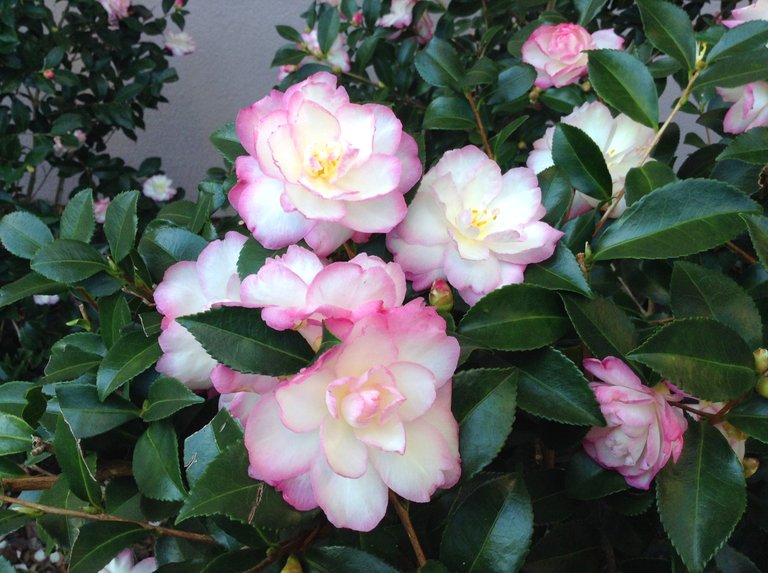
Other common names
camellia 'Jean May'
Family
Theaceae
Genus
Camellia are evergreen shrubs with simple, ovate, glossy, leathery leaves and showy flowers with solitary or clustered flowers early in the year
Details
'Jean May' is a compact, bushy evergreen shrub with dark foliage and slightly fragrant, semi-double or double, shell-pink flowers to 10cm across in winter and early spring
https://www.rhs.org.uk/Plants/96782/Camellia-sasanqua-Jean-May/Details
Camellia sasanqua 'Crimson King'
camellia 'Crimson King'
Other common names
camellia 'Crimson King'
Family
Theaceae
Genus
Camellia are evergreen shrubs with simple, ovate, glossy, leathery leaves and showy flowers with solitary or clustered flowers early in the year
Details
'Crimson King' is a medium-sized evergreen shrub of open and spreading habit, with fragrant, single bright rose-red flowers to 10cm in width.
https://encrypted-tbn0.gstatic.com/images?q=tbn:ANd9GcTJHo7qID7CGi5ODvMo-OiWceLM9ImgVa7RJZ0oyaBd1Lxio42z
https://www.rhs.org.uk/Plants/95712/Camellia-sasanqua-Crimson-King/Details
Camellia
Other common names
camellia 'Show Girl'
Family
Theaceae
Genus
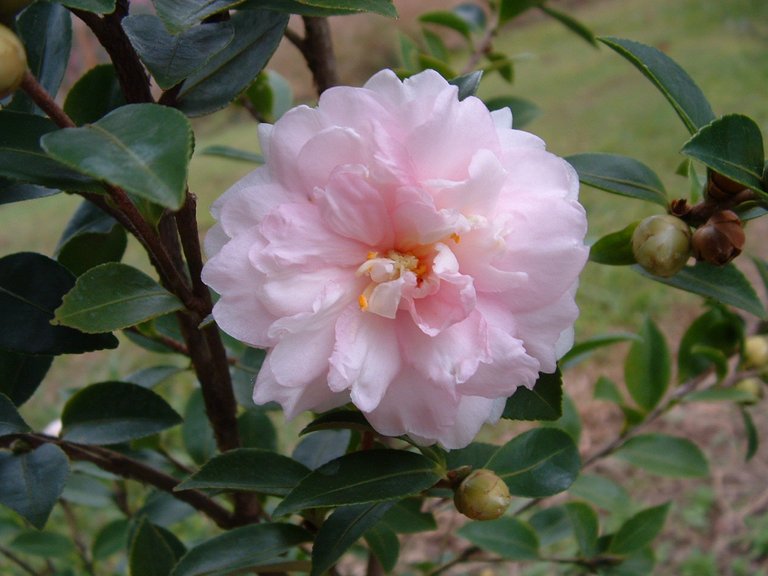
Camellia are evergreen shrubs with simple, ovate, glossy, leathery leaves and showy flowers with solitary or clustered flowers early in the year
Details
'Show Girl' is a vigorous upright shrub with large fragrant pale-pink flowers which are semi-double to peony form
https://www.rhs.org.uk/Plants/73185/Camellia-Show-Girl-(reticulata-×-sasanqua)/Details
Gardening / Time to make the most of camellias
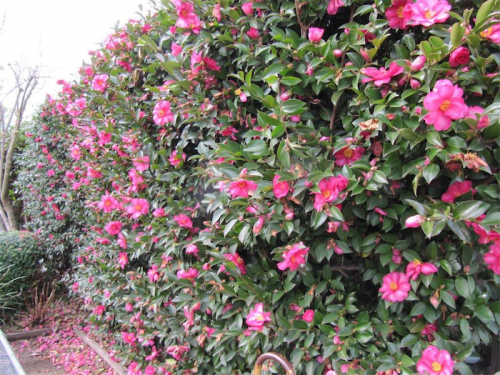
AUTUMN is the time for planting camellias.
When we had our Yass nursery, one customer expressed surprise we didn’t have a particular variety in stock. I politely explained that it was not possible to carry all varieties because, as the Camellia Society will verify, there are more than 38,000 named cultivars registered worldwide.
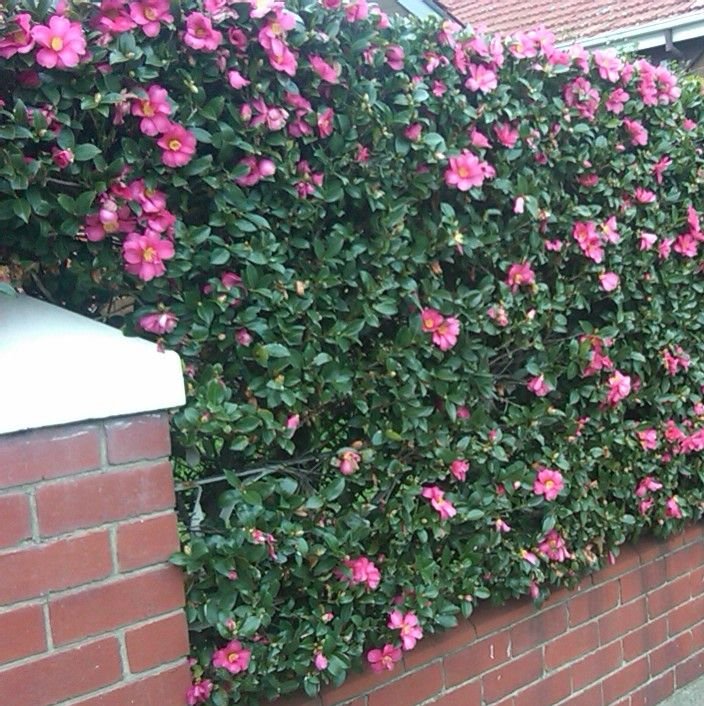
So, where to start in selecting from the plant’s huge range of colours and varieties?
Author Peter Valder, in his book “The Garden Plants of China”, says while many species of camellia occur in China, very few were brought into cultivation until recently.
There are exceptions such as Camellia sinensis, the tea camellia that has long been grown for its leaves.
In China, surprisingly, only a handful of indigenous species have been used as ornamental plants. Today we are all familiar with C. japonica, C. sasanqua, C. reticulata and C. williamsii.
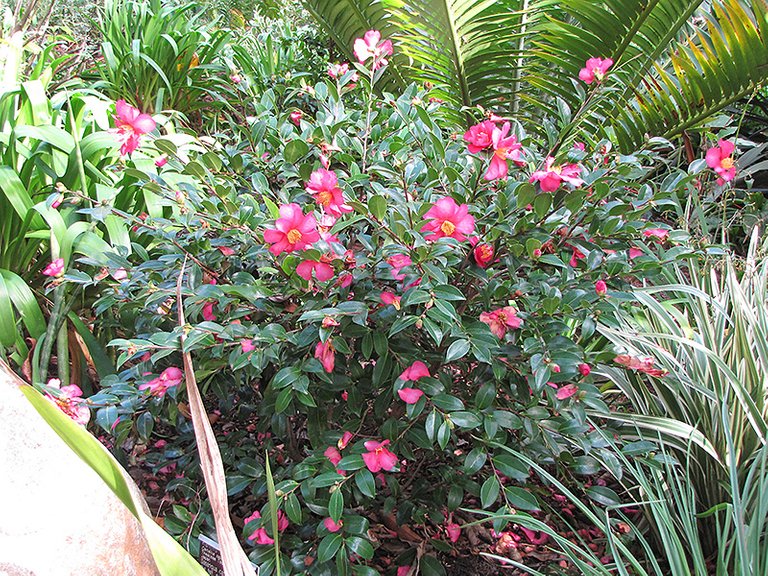
C. japonica, with its large, glossy leaves and huge flowers, blooms in spring and needs filtered shade.
C.sasanqua is one of the hardiest, even in our summer sun. Unlike most camellias, this one is scented. As illustrated here in our garden, C. sasanqua “Hiryu” makes an ideal hedge for screening, in this case it’s more than two metres tall. The added advantage is that it flowers in winter, which is important as it provides food for birds, especially honeyeaters, when most other plants, including native plants are dormant. Valder says that while cultivars of this type have been introduced into Western gardens, it’s rare to see this variety in Chinese gardens.
He describes the flowers of C. reticulata as having the “sumptuousness and mystique of tree peonies and our debt to generations of Yunnanese gardeners who long ago developed these wonderful plants,” adding that “this variety of camellia has been recorded from the 11th century. From that time these Yunnan camellias were praised by poets for their longevity and the beauty of their flowers”.

At the Yufeng Lamasery, in Tibet, there is an example of this camellia’s longevity, reputed to be more than 500 years old and bearing at least 4000 flowers. It is said that during the Chinese Cultural Revolution, 50 years ago, a monk risked his life by keeping it secretly watered. Modern breeders have produced some wonderful C. reticulata including “Dr. Clifford Parkes”, an informal double with rich red flowers; “William Hertrich”, a large semi-double with light red blossoms and “Valley Knudsen”, a compact, show-stopping, semi-double with luminous pink blossoms.
The Helleborus “Anna’s Red”... the leaves are growing at five centimetres a day!
link to
Camellias will grow in most well-drained slightly acid soil. A soil pH (degree of acidity or alkalinity) of 6.0 - 6.5 is considered best for camellias. However, they will tolerate a lower pH.
A soil test made before planting will tell you what is needed to bring the soil to the desired pH and fertility level. Practically all soils will benefit from the addition of organic matter when planting. Two to four inches of peat moss, leaf mold, ground aged bark, sawdust or cow manure worked into the soil improves both the drainage and fertility of the soil.
Camellias are generally planted in the late fall through the early spring, although they may be set out any month of the year if properly cared for. Adequate moisture is a necessity until the roots become well established in the soil. The newly developed roots will then provide enough moisture for the plant to start growth when spring arrives.
Allow a minimum of five feet between plants, and preferably more. When planting a hedge, a distance of three feet between plants is recommended.
https://www.americancamellias.com/care-culture-resources/general-culture-requirements/planting-camellias
Good afternoon. Camellia Eugenol (Camellia mountain, Sasankva)
LATIN NAME: CAMELLIA SASANGOA.
Sprawling evergreen shrub, Camellia eugenol (mountain) is grown not only as an ornamental plant. Its leaves and fruits contain a large number of essential oils, which are used for making perfume and confectionery fragrances, antiseptics, in microscopic technique and soap making.
Twigs thin, brown-green or reddish. Leaves are leathery, dark green, sit on short petioles. Flowers in comparison with other Camellias are very large. The petals are wide open, depending on the cultivar pink or white. Flowering during the month from September to December, fruits - red-brown dry capsules - ripen only by the next fall.
https://leplants.ru/camellia-sasanqua/
Oh, yes, the charming plant @ctrl-alt-nwo, Camellias are one of the most popular winter- and spring-flowering shrubs, providing a vivid splash of colour when little else is in bloom. Although they need acid soil, they are easy to grow in containers of ericaceous (acidic) potting compost.
Site and soil conditions
Camellias are woodland plants that grow best in shelter and light shade, although with careful watering they can be grown in sunny positions. They prefer free-draining conditions, with plenty of organic matter, such as leaf mould, incorporated into the soil.
Being ericaceous plants, camellias require an acid soil. If your soil isn't acid then consider growing your camellia in a container.
Pruning and training
Like other early-flowering shrubs, camellias form flower buds in late summer and autumn, especially on new growth. Pruning at this time could remove potential flowering growth. Therefore pruning is best done in spring, immediately after flowering and following the advice given for other evergreen shrubs.
Where an overgrown camellia needs to be reduced or renovated, hard pruning is usually safe and reliable.
Propagation
Camellias can be propagated from semi-ripe cuttings, hardwood cuttings, layering and grafting. Seed is also an option, but seedlings will not usually come true to parent type.
Semi-ripe cuttings often root better if slightly wounded by taking a 1.5cm (5/8in) strip of bark off the base of the cutting and dipping the wound in hormone rooting compound.
Hardwood cuttings are taken as for semi-ripe cuttings, but between autumn and late winter. They can root in three months.
https://www.rhs.org.uk/advice/profile?PID=327
Blooming camellias bring touch of spring!
The two most commonly grown kinds of camellia are sasanquas and japonicas. Sasanquas, which have an open, airy structure with smaller flowers and leaves, can handle more sun than the japonicas and tend to bloom earlier.
While few camellias are “fast growers,” (they typically reach six to 12 feet tall and wide in about10 to 15 years), the sasanqua varieties and some of the hybrids do grow more quickly than the japonicas. But, the flowers of the japonicas are longer lasting, so its a bit of a tradeoff.
Source
Japonicas, which are larger in overall size, with bigger leaves and flowers, thrive in shade and tend to bloom later in the season.
Source
Source
Low-maintenance, shade-loving, small trees or shrubs, camellias throw themselves into spellbinding bloom during the dull days from late fall into early spring, when there’s not much cheer happening in the garden. Available in a remarkable range of colors, forms, and sizes, camellias bloom in hues from white or pink to deep red. Some flowers are as simple as a wild rose while others as full blown as a peony. While you’ll grow them for the flowers, the evergreen dark glossy leaves look great year round.
Source
Source
Text Source
Camellia Sasanqua is the most beautiful plant in my opinion, with a different color and very spoil the eye of the beholder.
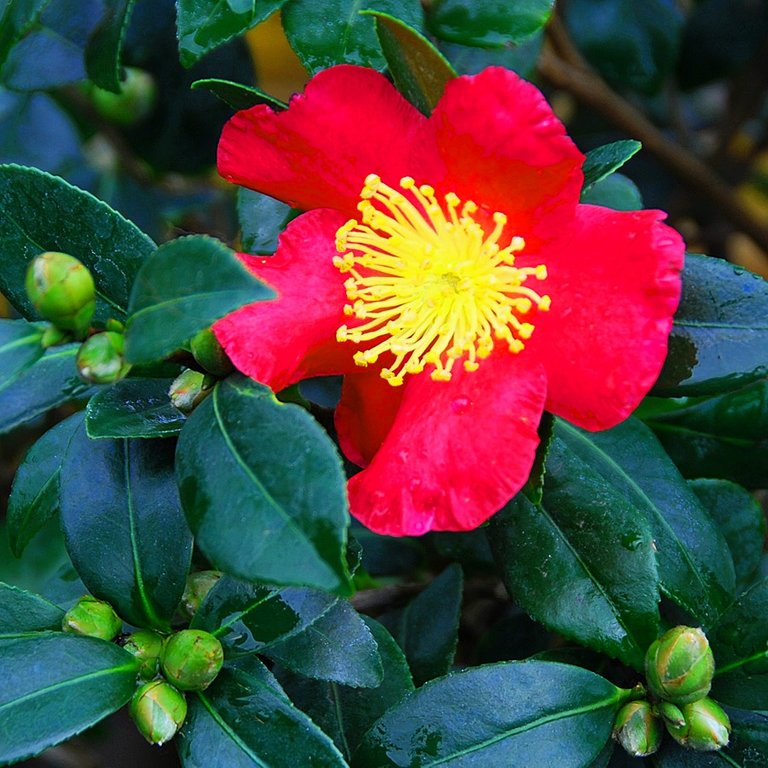

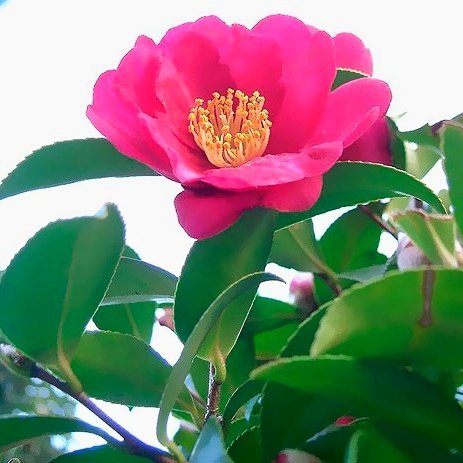

To my knowledge, this humus-rich plant grows well in tropical countries.
Camellias can grow up to 29 cm although depending on the geographic position of a country.
And now, Camellia Sasanqua is used for drinks, cosmetics, and internal medicine.
Thankyou @ctrl-alt-nwo!
Sources Image:
Horomidis Agronomic Corp.
Kelways
Wikipedia
Horomidis Agronomic Corp.
Camellia sasanqua!
Sasanqua camellias are native to China and Japan where they have contributed their beauty to gardens for centuries. While it's true that the "japonicas" have larger flowers, Camellia sasanqua has just as many endearing attributes.
Sasanquas have mature heights that range from about 4-15 ft (1.2-4.6 m). The taller cultivars are typically trimmed up as small trees. Sasanquas bear profusions of flowers in fall and early winter depending on cultivar and location. In general they blossom before japonica.
A beautiful sight is a solitary sasanqua in full bloom standing on the lawn in a spotlight circle of fallen blossoms. Even when not in bloom the sasanquas make a statement with their beautifully glossy, rich green leaves that excel at providing backdrops for garden
Neat form, beautiful evergreen foliage and tons of flowers make sasanquas a hit wherever they are planted. Small specimens are inexpensive and readily available. They are virtually pest free and can survive periods of neglect. Best of all, the blossoms come in all sorts of shapes and sizes.
Resources
This brilliant species, the most flexible all things considered, has extraordinarily expanded in fame in the course of recent years. Propelled trees are truly secured with dainty blossoms, which are made more obvious by the humble and typically dim green takes off. They bloom when there is little else in the garden through Autumn and into Winter.
Benifits:
It is a rich wellspring of cell reinforcements, vitamins, phytosqualene, and Omega-6 unsaturated fats. These fixings can give skin-improving advantages, for example, cell reinforcement security and saturating properties. Camellia japonica have lipids that have brilliant emollient, saturating properties.
Physical Characteristics:
Camellia sasanqua is an evergreen Shrub developing to 3 m (9ft) by 1.5 m (5ft) at a moderate rate.
It is tough to zone (UK) 8. It is in leaf 12-Jan It is in blossom from Oct to April. The species is bisexual (has both male and female organs) and are pollinated by Bees. Appropriate for: light (sandy) and medium (loamy) soils and inclines toward very much depleted soil. Appropriate pH: corrosive and impartial soils and can develop in extremely corrosive soils.
It can develop in semi-shade (light forest) or no shade. It inclines toward damp soil.
Different Names:
On the off chance that accessible different names are said here
Cha hua, Chamei, Kamelia sasangkua, Mei camellia, Perdu teh sasangkua
https://www.gardenia.net/plant-variety/Camellias-Sasanqua
Sasanqua camellia flowers earlier than the japonica types and can cope with more sunlight. They are hardy, grow easily and bloom prolifically. Camellia growers like to prune them into elegant lollipop trees. This keeps the plant in check and is perfect for smaller gardens.
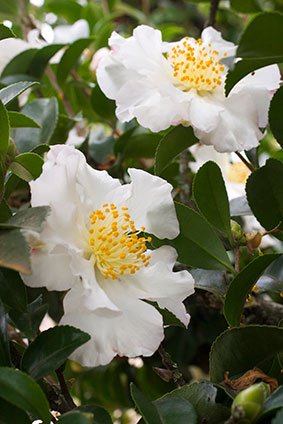
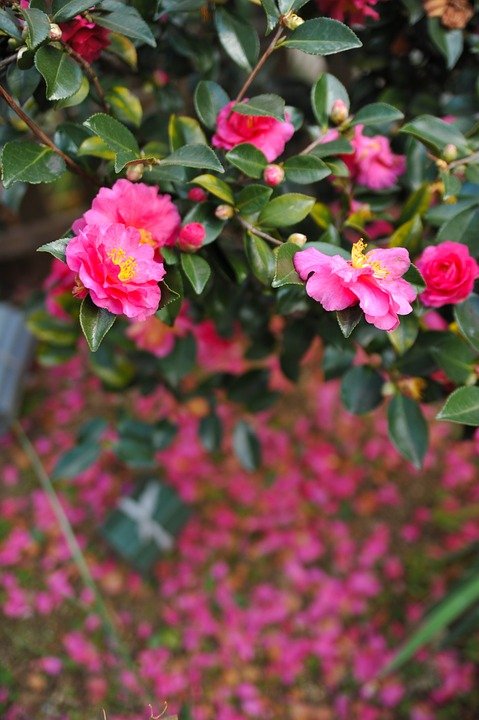
The 250 species of stately, winter-blooming evergreens that make up the genus Camellia originated in the East, but there are now more than 3 000 named hybrids found around the world. This makes it almost impossible to classify each of these ornamental shrubs or trees according to their botanical names and origins without the help of a camellia expert, so when we choose them for planting it is usually according to the type of flower. The blooms are described as being either single, semi-double, double or formal double, and in the shape of an anemone, peony or double rose. The flower sizes and colours differ dramatically from hybrid to hybrid; there are variations of white, pale white, soft pink, bright pink, shocking pink, watermelon pink, light red and very deep tomato red. In addition, some blooms have bold splotches of colour and some have protruding yellow filaments. Camellias, along with many of the other ‘old fashioned’ shrubs, have fallen out of favour somewhat, probably because they are slightly harder to propagate and take several years before they become marketable. Out of season and without their attractive blooms, they remain unappreciated in nurseries unless someone is specifically looking for them and knows the particular hybrid she seeks by name. However, they are on our list because they are one of the hardiest of the garden shrubs, and especially suitable for very cold and ‘difficult’ climates.
pictures by PIXABaY
Christmas camellia is an attractive shrub with beautiful white to red flowers and contrasting dark green evergreen leaves.
The genus Camellia includes over 200 species, including Camellia sinensis (tea), and many other species well known to gardeners around the world. Camellia sasanqua, which is native to Japan, is particularly valued for its autumn and winter flowering, although it prefers a mild climate and needs protection from the coldest weather.
Camellia sasanqua was named by Carl Peter Thunberg (1743-1828), a Swedish physician and botanist and a protégé of Linnaeus. Thunberg visited Japan (at that time closed to most Europeans) from 1775-1778 while in the employ of the Dutch East India Company, and many of the plants he saw there were described in his Flora Japonica, published in 1784.
Source
Sasanqua camellias form a dense evergreen hedge 2 to 3 metres tall in three to five years. When selecting camellias for hedging, choose named varieties that grow to the height and width required and space them 50 to 90 centimetres apart. Install a drip or micro-spray irrigation system along the length of the hedge to aid watering. Use stakes to support the new plants. The stakes can be removed as the trunk thickens after the first year.
One of the fastest-growing varieties for a hedge is ‘Plantation Pink’, which has single pink flowers. It is also suited to espalier.
Other reliable choices for tall hedges include ‘Jennifer Susan’ (pale pink double flowers), ‘Paradise Emily’ (pink semi-double flowers), ‘Paradise Jennifer’ (white semi-double flowers edged with pink) and ‘Pure Silk’ (white informal-double flowers flushed with pink). All grow to around 3 to 4 metres high.
For a low-growing one-metre-high hedge, select ‘Paradise Little Liane’ (white double flowers), ‘Paradise Sylvia’ (crimson-red single flowers) or another dwarf camellia.
source https://www.flowerpower.com.au/gardening/sasanqua-camellias/
The Camellia sasanqua is native to Japan and is one of few plants, including Camellia japonica, which color gardens during desolate wintry scenes. At the Botanical Garden of Everyday Life, Camellia sasanqua has been exhibited since 2001 as part of the special program “traditional seasonal plants.” It also includes the unique varieties known as “Edo Camellia sasanqua” and “Higo Camellia sasanqua”.
Camellia sasanquas are broadly divided into three groups: the “Camellia sasanqua group,” which is close to the native species; the “Camellia x hiemalis group,” which is regarded as the seedling or progeny of Shishigashira; and the “Camellia x vernalis group,” which is regarded as a natural cross-breed of Camellia sasanqua and Camellia japonica or its progeny. Camellia sasanqua blooms from mid-October to February the following year by grouping it in the above-mentioned order. All these varieties were selected from variants of seedling, and it can be said that the methods for maintaining and spreading such varieties considerably characterize Japanese gardening culture.
At this Botanical Garden, focusing on the relationship between people and Camellia sasanqua from aspects of both genetic and cultural resources, we have studied living plants and historical materials together and exhibited the results. In this year’s program “Winter Flowers - Camellia sasanqua,” with the theme of the names of Camellia sasanqua, the change of the origin of the name with the times and the grouping by variety are exhibited.
source
your post alltime fantastic.because alltime showing alots of flower post in your blog.its very perfect and original. Camellia sassanqua 'Shishi Gashira' - Known for its beautiful flowers and long blooming season. Dark pink flowers 2-3 inches across are produced in abundance from October to January. The ShiShi Gashira camellia is a slow-growing shrub that can reach 5 feet tall but is more typically around 3 feet. It is often called a dwarf sasanqua because it is smaller-growing than typical sasanquas. The compact growth habit and slow rate of growth make ShiShi Gashira an excellent choice for smaller gardens, foundation plantings, containers and basically anywhere a smaller shrub is needed. It truly would be hard to find a finer, more attractive and reliable, low-growing shrub for Louisiana landscapes. Every garden should have a Shishi Gashira Camellia, named a Louisiana Super Plant by the LSU AgCenter.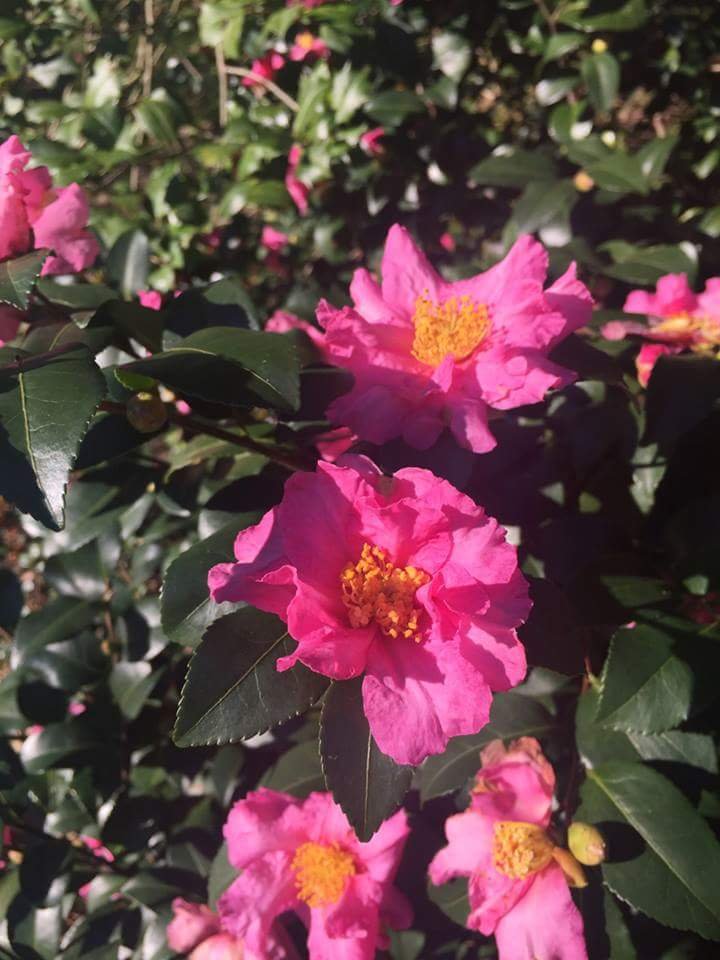
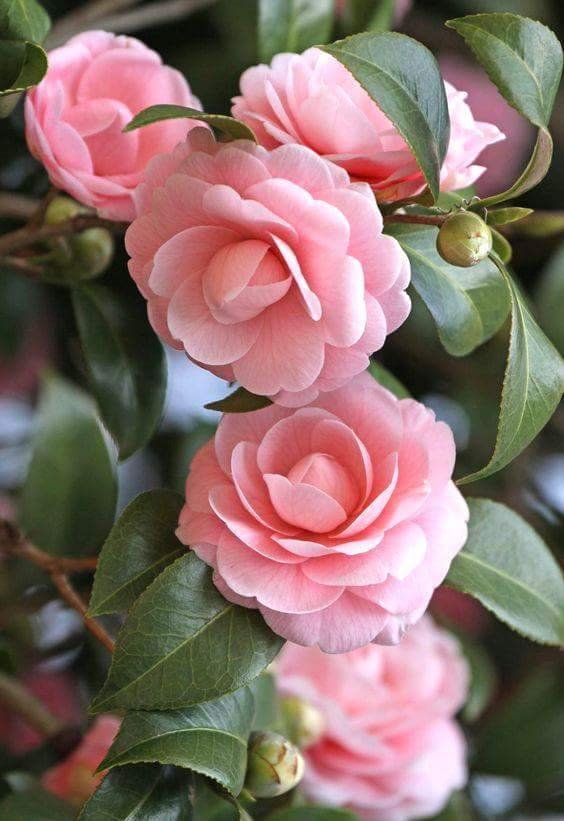 Marvelous late fall planting combination: Acer palmatum Ryusen shining red and gold behind Camellia sassanqua Bonanza with American Boxwoods in the mid ground....all this color in Atlanta in December!
Marvelous late fall planting combination: Acer palmatum Ryusen shining red and gold behind Camellia sassanqua Bonanza with American Boxwoods in the mid ground....all this color in Atlanta in December! 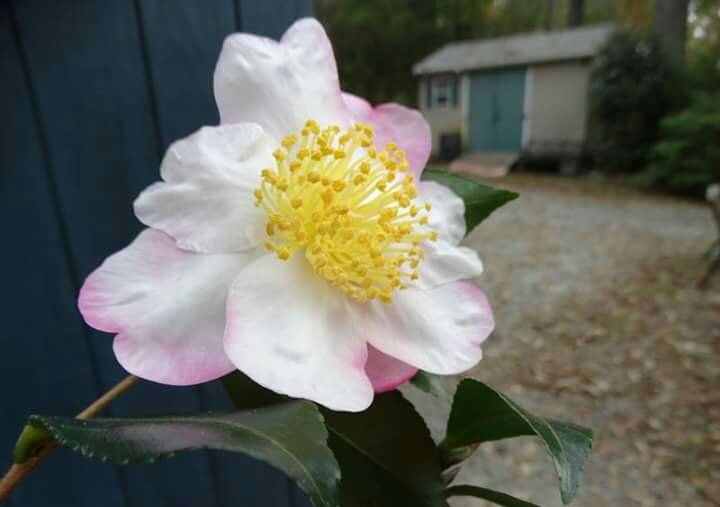 Marvelous late fall planting combination: Acer palmatum Ryusen shining red and gold behind Camellia sassanqua Bonanza with American Boxwoods in the mid ground....all this color in Atlanta in December!
Marvelous late fall planting combination: Acer palmatum Ryusen shining red and gold behind Camellia sassanqua Bonanza with American Boxwoods in the mid ground....all this color in Atlanta in December! 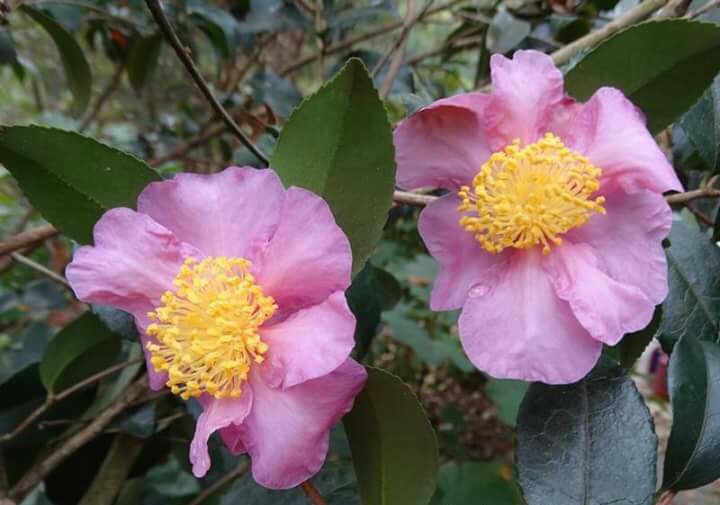 Camellia sassanqua, nice to get flowers! These are fall flowering camellias but often it is too cold here on the north shore to see flowers.
Camellia sassanqua, nice to get flowers! These are fall flowering camellias but often it is too cold here on the north shore to see flowers. 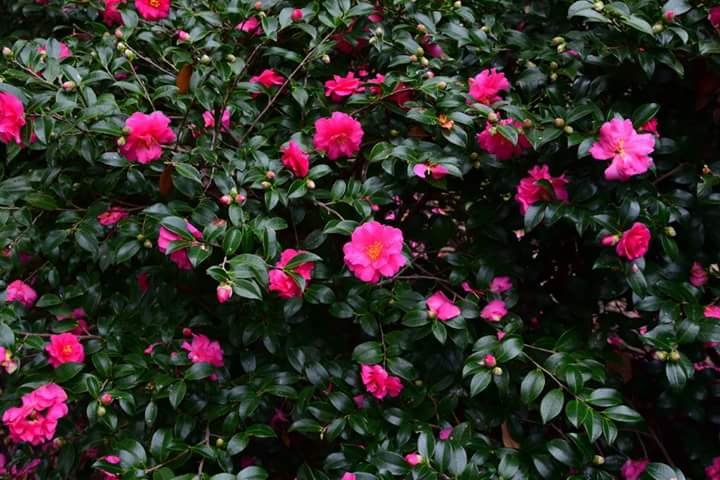 The white and pink varieties of the Japanese Wind Flowers (Anemone x hybrid) are on display within the Garden at the moment. These perennial plants flower in early autumn and enjoy sunny / semi sun and moist positions. To encourage healthy regrowth, remove spent flower spikes and dead leaves in winter. It is best to feed with a new dose of compost or mulch in late winter before fresh growth begins.thanks to sharing for your great and best post of flower cameliea.very well done.take care yourself and best of luck of your great work.may god bless you.your post always amazing..my dear friend.. @ctrl-alt-nwo
The white and pink varieties of the Japanese Wind Flowers (Anemone x hybrid) are on display within the Garden at the moment. These perennial plants flower in early autumn and enjoy sunny / semi sun and moist positions. To encourage healthy regrowth, remove spent flower spikes and dead leaves in winter. It is best to feed with a new dose of compost or mulch in late winter before fresh growth begins.thanks to sharing for your great and best post of flower cameliea.very well done.take care yourself and best of luck of your great work.may god bless you.your post always amazing..my dear friend.. @ctrl-alt-nwo
Autumn sees the beginning of camellias in our garden. We did plant rather enthusiastically when we first came here. Fortunately at that time many odd camellias were being brought into Australia by Erica McMinn (Camellia Lodge, Melbourne), Camellia Grove (Sydney) and members of the Australian Camellia Research Society so I was able to buy some interesting kinds - well, at least they interested me, Stirling Macoboy and Prof. Water
Sasanqua Camellias

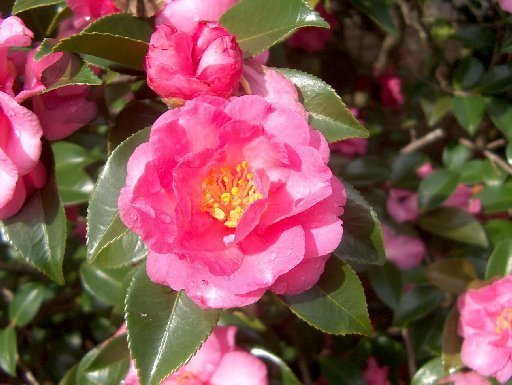

With flowers from late summer to winter, sasanqua camellias make a long impact on the garden. Their flowers, which may be white, pink or red and range from single to double, are also attractive to nectar-eating birds including parrots and to beneficial insects. Many sasanquas are also lightly perfumed and can be picked for a floral arrangement.
In the garden, sasanqua camellias grow as evergreen shrubs from a compact one metre high to more than four metres high. Large forms left unpruned may become small trees. Sasanquas can be grown as specimen plants but their ideal role in the garden is to be grown as dwarf, medium or tall hedges. Camellias can also be grown in large containers in a courtyard, on a deck, or as statement plants at the main entrance to your home. Where space is restricted, train them as espaliers flat against a wall. They can also be shaped as topiary balls or as more fanciful forms.
Camellias for hedges
Sasanqua camellias form a dense evergreen hedge 2 to 3 metres tall in three to five years. When selecting camellias for hedging, choose named varieties that grow to the height and width required and space them 50 to 90 centimetres apart. Install a drip or micro-spray irrigation system along the length of the hedge to aid watering. Use stakes to support the new plants. The stakes can be removed as the trunk thickens after the first year.
One of the fastest-growing varieties for a hedge is ‘Plantation Pink’, which has single pink flowers. It is also suited to espalier.
Other reliable choices for tall hedges include ‘Jennifer Susan’ (pale pink double flowers), ‘Paradise Emily’ (pink semi-double flowers), ‘Paradise Jennifer’ (white semi-double flowers edged with pink) and ‘Pure Silk’ (white informal-double flowers flushed with pink). All grow to around 3 to 4 metres high.

For a low-growing one-metre-high hedge, select ‘Paradise Little Liane’ (white double flowers), ‘Paradise Sylvia’ (crimson-red single flowers) or another dwarf camellia.
Planting and ongoing care
Camellias can be planted year round, but the best planting time is autumn to winter. Sasanqua camellias thrive in slightly acidic soil (a pH of around 5 to 6) with several buckets of compost and aged manure dug in before planting. Regular moisture while they become established is vital, but well-established plants are drought tolerant and can withstand dry periods.

They grow in light shade but also tolerate full sun. A site with morning sun and afternoon shade is ideal.
In areas with alkaline soil (pH above 7) grow camellias in large containers filled with a potting mix for acid-loving plants.
Prune sasanquas after flowering in late winter. Tip: pruning encourages a bushy plant, while harder pruning is used to shape a hedge. Hard pruning is used to renovate sparse, leggy or oversized plants. Avoid pruning between summer and autumn when sasanquas are forming buds.

Fertilise sasanqua camellias in late winter or early spring after pruning and as new growth appears. Use a specialist camellia food or a slow-release fertiliser for flowering shrubs. As well, apply a 2 to 3 centimetre layer of organic mulch mixed with well-rotted manure over the root system to help keep the soil moist and cool. Water plants deeply before applying fertiliser or mulch.
Main source
magoo-2 found a series of multi accounts of a same owner is following your articles to cheat your generous rewards.
magoo-2 found these accounts are suspicious & can be multi accounts of a single owner. Conclusion is based on last 30 days transactions:
@moniristi
@shishiristi
magoo-2
Check our latest multi comment spam update report
This beautiful and meaningful flower, now spread all over the country.
In addition to beautiful, one of the charm, the aroma is very tempting. In my country, camellia is widely used as a girl's name to symbolize: immortality, beautiful, fragrant, and popular.
In addition, camellia leaf shoots are widely used as tea, be it commercial that is packaged in a bottle or consumed personally because it has many benefits, such as eliminating asthma, treating coronary heart disease and for immunity.
Until now, the cultivation of camelia continues to be done intensively.
Camelia sasanqua flowers also consist of various types, such as the flowers I took in google below.
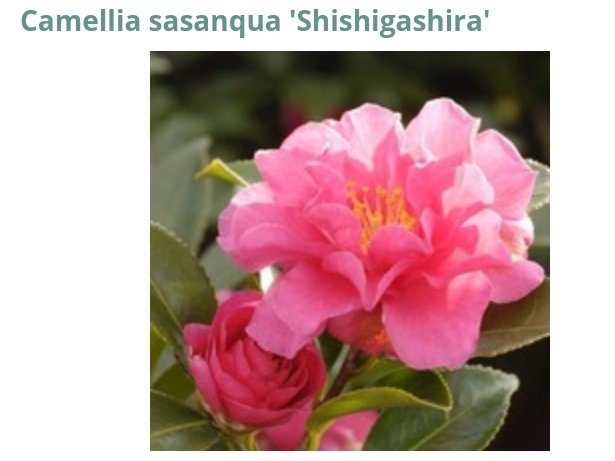
Have a wonderful and fun day always @ctrl-alt-nwo!
Image from Google
Article from @seha76!
magoo-2 found a series of multi accounts of a same owner is following your articles to cheat your generous rewards.
magoo-2 found these accounts are suspicious & can be multi accounts of a single owner. Conclusion is based on last 30 days transactions:
@seha76
@faisalrizal2018
@roman-sabil
magoo-2
Check our latest multi comment spam update report
Camellia sasanqua 'Plantation Pink'
camellia 'Plantation Pink'
Other common names
camellia 'Plantation Pink'
Family
Theaceae
Genus
Camellia are evergreen shrubs with simple, ovate, glossy, leathery leaves and showy flowers with solitary or clustered flowers early in the year
Details
'Plantation Pink' is a vigorous, upright evergreen shrub with glossy dark-green leaves and large, scented single to semi-double pink flowers in late autumn to early winter
https://www.rhs.org.uk/Plants/94548/Camellia-sasanqua-Plantation-Pink/Details
magoo-2 found a series of multi accounts of a same owner is following your articles to cheat your generous rewards.
magoo-2 found these accounts are suspicious & can be multi accounts of a single owner. Conclusion is based on last 30 days transactions:
@rik432
@ratul8940
@rahul72
@villani
@Wilson
@masud90
@purepinag
@sumonsha
@max1994
magoo-2
Check our latest multi comment spam update report
This delightful species, the most versatile of all camellias, has greatly increased in popularity over the past few years. Advanced trees are literally covered with dainty blooms, which are made more conspicuous by the diminutive and usually dark green leaves. They flower when there is little else in the garden through Autumn and into Winter.

Long Blooming Camellias
Camellia sasanqua 'Petite White' pbr — Warners Nurseries.
Purple Haze Sasanqua Camellia
Colour the cold with Camellias
Benifits:
It is a rich source of antioxidants, vitamins, phytosqualene, and Omega-6 fatty acids. These ingredients can provide skin-enhancing benefits such as antioxidant protection and moisturizing properties. Camellia japonica possess lipids that have excellent emollient, moisturizing properties.
Physical Characteristics:
Camellia sasanqua is an evergreen Shrub growing to 3 m (9ft) by 1.5 m (5ft) at a slow rate.
It is hardy to zone (UK) 8. It is in leaf 12-Jan It is in flower from Oct to April. The species is hermaphrodite (has both male and female organs) and are pollinated by Bees. Suitable for: light (sandy) and medium (loamy) soils and prefers well-drained soil. Suitable pH: acid and neutral soils and can grow in very acid soils.
It can grow in semi-shade (light woodland) or no shade. It prefers moist soil.
Other Names:
If available other names are mentioned here
Cha hua, Chamei, Kamelia sasangkua, Mei camellia, Perdu teh sasangkua, Sazanka, Shan cha, So, Tra-mai,
Found In:
Countries where the plant has been found are listed here if the information is available
Asia, Australia, Britain, China, Hawaii, India, Indochina, Indonesia, Japan, Laos, Pacific, SE Asia, Tasmania, USA, Vietnam,
Camellia sasanqua 'Rainbow'
camellia 'Rainbow'
Other common names
camellia 'Rainbow'
Family
Theaceae
Genus
Camellia are evergreen shrubs with simple, ovate, glossy, leathery leaves and showy flowers with solitary or clustered flowers early in the year.
Details
'Rainbow' is a vigorous, upright large shrub or small tree, up to 6m high, with leaves, up to 8cm long, that are purple when young, then glossy bright green above and paler beneath. From autumn to early winter it produces fragrant single flowers, up to 7cm across, which have white petals edged with pink, and conspicuous golden yellow stamens.
https://www.rhs.org.uk/Plants/28532/Camellia-sasanqua-Rainbow/Details
magoo-2 found a series of multi accounts of a same owner is following your articles to cheat your generous rewards.
magoo-2 found these accounts are suspicious & can be multi accounts of a single owner. Conclusion is based on last 30 days transactions:
@rik432
@ratul8940
@rahul72
@villani
@Wilson
@masud90
@purepinag
@sumonsha
@max1994
magoo-2
Check our latest multi comment spam update report
Camellia sassanqua
Some blossoming bushes can coordinate (Camellia spp.) For brilliant, fragile blooms and glossy green takes off. The sex incorporates in excess of 200 species, including Camellia Sasanco (Camellia Sassanco), with gleaming red blossoms, and Japanese (Camellia Jabonica), well known for its blooms and accessible in excess of 3,000 assortments, assortments and cakes.
Sasanqua Camellia and camellia are evergreen bushes that are solid in solidifying regions of US Department of Agriculture 7 to 9 and 6 to 9, separately. Like all camellias, they flourish when appropriately developed and fractional shade is given, adequate dampness and a little consideration now and now.
Beautiful flower and pefect for garden decoration. The genus Camellia includes over 200 species, including Camellia sinensis (tea), and many other species well known to gardeners around the world. Camellia sasanqua, which is native to Japan, is particularly valued for its autumn and winter flowering, although it prefers a mild climate and needs protection from the coldest weather.
Thanks to share, really I'm so happy your post because knowing lots of flowers that hadn't any idea before, thanks again.
magoo-2 found a series of multi accounts of a same owner is following your articles to cheat your generous rewards.
magoo-2 found these accounts are suspicious & can be multi accounts of a single owner. Conclusion is based on last 30 days transactions:
@rupok
@sarahmcdowell2
@razu788
@tangera
magoo-2
Check our latest multi comment spam update report
hey man what do you mean by suspicious? other account are not mine.. dont mention me either.
Sasanqua camellias are a drought tolerant fall blooming shrub that work well as an accent plant, hedge, or tall foundation planting. Pruned up it makes for a good "small tree" form. There are numerous cultivars available, including dwarf forms. Does well in containers and container plants can be overwintered indoors in greenhouses or cool but bright sunrooms to protect from frost.
The Camellia sasanqua is one of the joys of Autumn and Winter with it's beautifully fragrant flowers through an extended period. It is a smaller leaved, and faster growing cousin the the Camellia japonica. Sasanquas are best grown in the full sun, and make good specimen plants or are great as a screen or hedge. They come in many varieties, dwarf plants of tall growing plants, and are available in many colours. You can also choose from single flowered varieties, or double flowered. Flowers of the older varieties have a great smell or perfume. "Plantation Pink" is a single-flowered variety which is taller growing, the flowers have an intense perfume which makes it my favourite. Native to China and Japan, these plants are best suited to temperate or Cooler climates.
The photos of these Sasanquas were taken locally in Sydney.
Thanks for sharing this post @ctrl-alt-nwo.
magoo-2 found a series of multi accounts of a same owner is following your articles to cheat your generous rewards.
magoo-2 found these accounts are suspicious & can be multi accounts of a single owner. Conclusion is based on last 30 days transactions:
@stardivine
@invinciblelight
@lovehaswon
magoo-2
Check our latest multi comment spam update report
Camellia sassanqua is amazing always love your work as you share rare plants.
This is very beautiful garden and beautiful photography. .it is very looking.
@ctrl-alt-nwo
Have a great day
That is a amazing trees and really beautiful flowers. the beat garden.

Thanks for the information.
100% like and resteem
@ctrl-alt-nwo

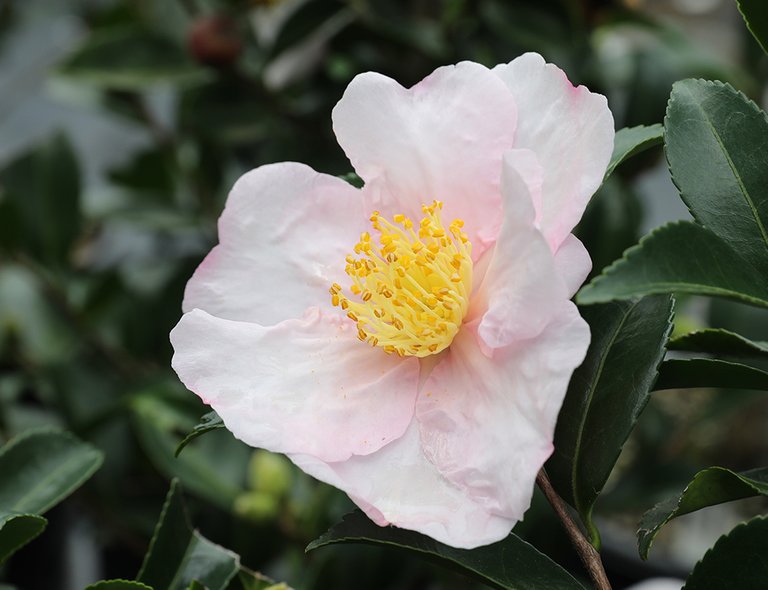
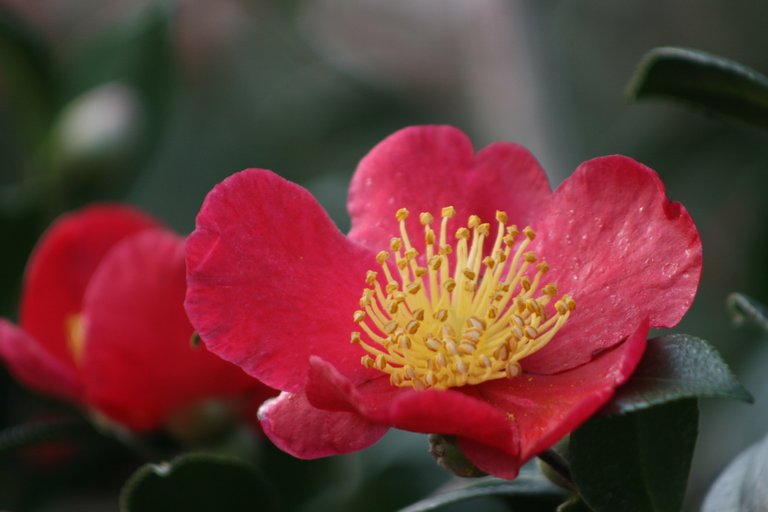
Wonderful Australia Buckinghamia Plant. this is valuable article.
Resteem
@ctrl-alt-nwo

This is really information of Australia flowers garden. that is helpfully and fantastic.
Resteem service
Beauty Camellia! I have not seen these flowers for years!
How I miss them very much!
My close friend had a very bush in her garden!
Those were white Camellias, so pure and so beautiful!!
Reminding me of good old days!!
Cheers.
These looks very great interesting plant details you shared today thanks for sharing :)
They sure are beautiful flowers and they are in a perfect place and as it seems they are indeed one of my favorite color as well !
Very nicely taken shots as well !
This delightful species, the most versatile of all camellias, has greatly increased in popularity over the past few years. Advanced trees are literally covered with dainty blooms, which are made more conspicuous by the diminutive and usually dark green leaves. They flower when there is little else in the garden through Autumn and into Winter.
Wow amazing & beautiful Camellia sassanqua flowers garden.

For your post propagation.
Upvote/Resteem